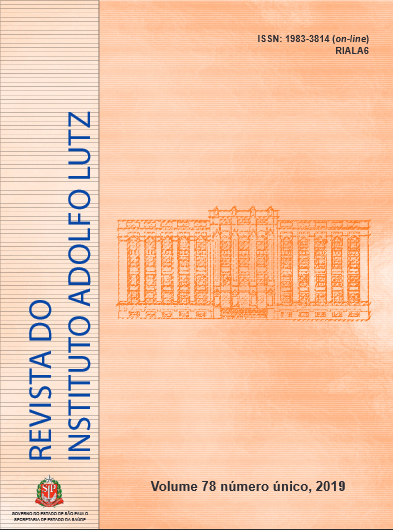Abstract
Meat sausages are among the mostly consumed and commercialized products, and they are
the important source of contamination by pathogenic or deteriorating microorganisms due to
the excessive manipulation, the increased surface contact and the considerable exposure to the
atmospheric contents. The objective of this study was to evaluate the microbiological quality of
sliced mortadella commercialized in Fortaleza, CE. Twelve samples of mortadella from different
brands were collected in supermarkets located in Fortaleza, CE, and they were sliced and packed
at the time of purchase. The samples were evaluated by the microbiological analyses for detecting
the occurrence of thermotolerant coliforms, coagulase positive staphylococci and presence/absence
of Salmonella spp. The results from the present study showed that all of the analyzed samples were
within the standards established by the Brazilian legislation. The occurrence of coliforms and
coagulase-positive staphylococci in food, even at lower levels than those recommended by current
legislation, they indicate the unsatisfactory sanitary hygienic conditions. Therefore, it is emphasized
the need to adopt the good practices in supermarkets and a major supervision by the responsible
agencies, in order to minimize the occurrence of possible public health problems.
References
peru fatiado e embalado em atmosfera modificada
[dissertação de mestrado]. Niterói (RJ): Universidade
Federal Fluminense; 2012. Disponível em: https://
pesquisa.bvsalud.org/portal/resource/pt/vtt-577
2. Cenci DF. Estudo da influência de variáveis do processo
emulsificação de mortadela de frango [dissertação
de mestrado]. Erechim (RS): Universidade Regional
Integrada do Alto Uruguai e das Missões – URI
ERECHIM; 2013. Disponível em: http://www.uricer.
edu.br/cursos/arq_trabalhos_usuario/2294.pdf
3. Fachinello JP, Casaril KBPB. Avaliação da qualidade
microbiológica de presuntos fatiados, comercializados
no município de Francisco Beltrão, Paraná. Alim
Nutr [Internet]. 2013;24(3):333-7. Disponível em:
http://docplayer.com.br/24872279-Avaliacao-daqualidade-microbiologica-de-
presuntos-fatiadoscomercializados-no-municipio-de-franciscobeltrao-parana.html
4. Sá MJF, Macedo RO, Leandro LMG, Almeida BS,
Fonseca FLA. Avaliação microbiológica do presunto
fatiado comercializado na cidade de Juazeiro do
Norte-CE. Hig Aliment. 2016; 30(258/259):129-
33. Disponível em: http://docs.bvsalud.org/
biblioref/2016/11/2625/separata-129-133.pdf
5. Alves E, Giaretta AG, Costa FM. Higiene pessoal dos
manipuladores de alimentos dos shoppings centers
da região da grande Florianópolis. Rev Técnico
Científica (IDSC) [Internet]. 2012;3(1):604-14.
Disponível em: http://periodicos.ifsc.edu.br/index.
php/rtc/article/view/737/488
6. Ministério da Saúde (BR). Agência Nacional de
Vigilância Sanitária. Resolução RDC nº 12, de 02 de
janeiro de 2001. Regulamento Técnico sobre Padrões
Microbiológicos para Alimentos. Diário Oficial da
União, Poder Executivo, de 10 de janeiro de 2001.
Seção 1, Pág. 45.
7. Silva N, Junqueira VCA, Silveira NFA. Manual de
métodos de análise microbiológica de alimentos.
3.ed. São Paulo: Varela; 2007.
8. Santos RBF, Albuquerque MM, Rall VLM. Qualidade
higiênico-sanitária de frios pré fatiados, comercializados na
cidade de Botucatu. Hig Aliment. 2013;27(224/225):177-
81. Disponível em: http://hdl.handle.net/11449/137227
9. Kaminski S, Barreto ES. Coliformes totais e termotolerantes
de presunto fatiado comercializado em supermercados
do município de Sorriso - Mato Grosso, Brasil. Rev Bras
Educ Saúde 2013;3(3):59-63. Disponível em: https://
www.gvaa.com.br/revista/index.php/REBES/article/
view/2358/1838
10. Shinohara NKS, Barros VB, Jimenez SMC, Machado
ECL, Dutra RAF, Lima Filho JL. Salmonella spp.,
importante agente patogênico veiculado em alimentos.
Ciênc. Saúde Coletiva. 2008;13(5):1675-83. http://
dx.doi.org/10.1590/S1413-81232008000500031
11. Oliveira JF, Silva UR, Pastore VAA, Azevedo EC,
Campos GM, Silva FCG et al. Determinação
espectrofotométrica de nitrito em produtos cárneos
embutidos. Rev Bras Hig Sanid Anim. 2017;11(1):19-
31. Disponível em: http://www.higieneanimal.
ufc.br/seer/index.php/higieneanimal/article/
view/377/1971
12. Bagestan MM. Perfil sensorial, físico, químico
e microbiológico de embutido de peito de peru
(Maleagris gallopavo) defumado [dissertação
de mestrado]. Florianópolis (SC): Universidade
Federal de Santa Catarina; 2012. Disponível
e m : http s : / / re p o s itor i o. u f s c . br / bit st re am /
h a n d l e / 1 2 3 4 5 6 7 8 9 / 1 0 3 4 0 3 / 3 1 6 5 0 8 .
pdf?sequence=1

This work is licensed under a Creative Commons Attribution 4.0 International License.
Copyright (c) 2019 Instituto Adolfo Lutz Journal
